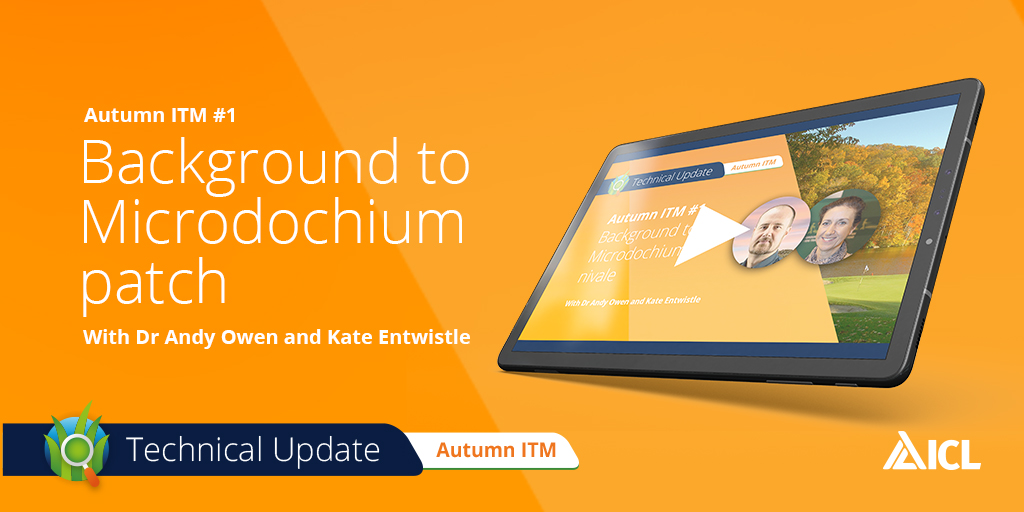By Andy Owen and Henry Bechelet, Technical Managers ICL
It’s that time again when we all start bearing down on disease activity. It is always vitally important to keep the greens from becoming damaged during autumn and winter but this year especially so with the Masters being scheduled for November!
There are a few simple measures that can really help you minimise Microdochium patch disease activity. It is important to maintain turf health with appropriate nutrition and the well-timed use of iron sulphate. You will also need to limit the presence of moisture in and around the leaf canopy to make the environment less conducive for the disease. Lastly, you must use fungicides correctly during times of high disease pressure if they are to effectively control the pathogen before the damage is done.
We call this type of joined up approach “Integrated Turf Management” or ITM because it combines the separate disciplines of plant health, environmental management and fungicidal control measures into a coherent and focused effort to make the results as effective as possible. We know that Microdochium nivale is an extremely aggressive pathogen during the autumn and winter and so it is imperative that we do everything in our power to suppress and then control its activity.
To allow us to talk about the subject of ITM in greater depth and with specialist guest speakers, we have produced a series of video discussions. The videos are listed below and they may be found from this link https://bit.ly/ICL_ITMPlaylist.
Video 1: Background to Microdochium patch with Dr Kate Entwistle, The Turf Disease Centre.
Video 2: What is integrated disease management?
Video 3: Managing Microdochium patch with a fungicide programme with Glenn Kirby, Syngenta.
Video 4: Early ICL Microdochium patch trial work - testing technologies
Video 5 Successful ITM trial in practice
Video 6: Practical outcomes from all the trial work with Phil Collinson, Area Manager ICL
Video 7: Special Bonus in-depth trial discussion edition
We cover a lot of ground in each of these videos and our aim is to help you put together more effective and properly integrated disease control programmes.
If we were to summarise, the key take home messages would be:
- Maintain plant health with the appropriate use of nitrogen during the autumn and winter. Plant health has a huge impact on the level of disease activity. Our trials always show that too little nitrogen is just as bad as too much when it comes to Microdochium patch. It is difficult (and probably wrong) to prescribe amounts, but you might aim to apply 1-2 kg/ha of Nitrogen per week if the turf is still functioning during the autumn and winter. We think that this should be delivered in slow release form (such as methylene urea) or as sulphate of ammonia or a combination of them both.
- Sulphate of Iron should be deployed when disease pressure is on the rise. Sulphate of Iron has always been used at this time as a “turf hardener” during autumn and winter. Our trials show that this can really help slow down the rate of development of Microdochium patch disease BUT only when applied at the right time. Sulphate of Iron should be applied when the development of the disease is imminent rather than at regular intervals as a part of a routine.
- Moisture management is a vital measure against the development of Microdochium patch disease. Leaf moisture is a key driver for the development of Microdochium patch and so anything you can do to keep the leaf canopy and turf base as dry as possible will help slow the rate of disease development down. We have always ‘switched’ the surface to remove dew, but our trials show that surfactant technologies, such as DewSmart dew dispersant and FlowSmart penetrant, can provide huge benefits when used as part of an integrated disease management plan.
- Use fungicides correctly. Fungicide technologies are by far the most important and effective element of any ITM plan. It is important that you select the correct product and time its application properly. The Syngenta fungicides Instrata Elite (a.i. difenoconazole + fludioxonil) and Medallion TL (a.i. fludioxonil) should both be applied preventatively when disease pressure is becoming high to achieve fully effective control. Refer to greencast.co.uk for more detailed advice.
Your ITM disease control strategy should aim to marry up all the different approaches outlined above into a single and coherent programme so that they can all work together. Take a look at the videos if you feel like you need a refresher, your understanding is the key to success.

